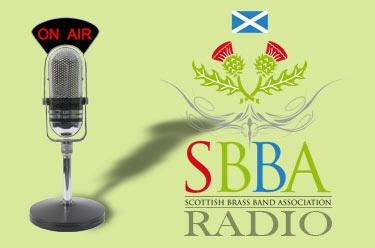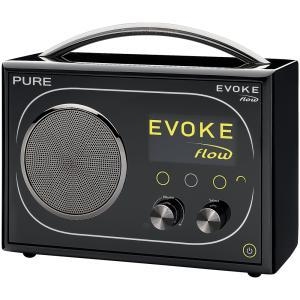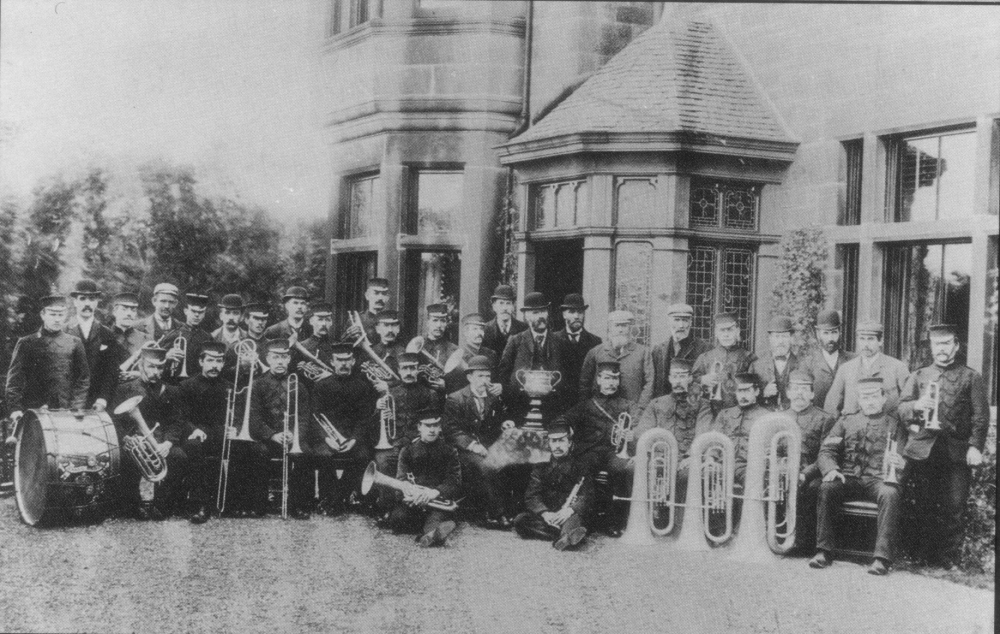SBBA Radio

New Gorbals Brass Band - Mark Good reports
You can download programme here or stream it below
[AUDIO=11,0]https://www.sbba.org.uk/FILES/SBBA/RADIO/GorbalsYouthBrassBandLaunch.mp3[/AUDIO]
2012 Solo & Ensemble Competition report, plus a new CD from Kingdom Brass presented by Mark Good
You can download programme here or stream it below
[AUDIO=10,0]https://www.sbba.org.uk/FILES/SBBA/RADIO/SBBARadioSolosandEnsFeb2012.mp3[/AUDIO]
Scottish Challenge Shield 2011 presented by Mark Good
You can download programme here or stream it below
[AUDIO=9,0]https://www.sbba.org.uk/FILES/SBBA/RADIO/Scottishchallenge2011.mp3[/AUDIO]
Scottish Brass Band Association Conference/AGM
Report by Mark Good
You can download programme here or stream it below
[AUDIO=8,0]https://www.sbba.org.uk/FILES/SBBA/RADIO/SBBAConferenceAGM2011.mp3[/AUDIO]
NYBBS and National Youth Pipe Band at Glasgow Royal Concert Hall
You can download programme here or stream it below
[AUDIO=7,0]https://www.sbba.org.uk/FILES/SBBA/RADIO/SBBARadioNYBBSNYPBoS.mp3[/AUDIO]
West Lothian Festival 2011 presented by Mark Good & Alan Edmond
You can Download the Programme here or stream it underneath
[AUDIO=6,0]https://www.sbba.org.uk/FILES/SBBA/RADIO/SBBARadioWLC2011.mp3[/AUDIO]
Scottish Championships 2011 Perth Winners Compilation Programme
You can Download the Programme here or stream it underneath
[AUDIO=5,0]https://www.sbba.org.uk/FILES/SBBA/RADIO/WinnersCompilationPerthFebruary2011v3.mp3[/AUDIO]
PART 1 - WEST LOTHIAN FESTIVAL 2010
You can download the Radio programme here or stream it underneath.
[AUDIO=1,0]https://www.sbba.org.uk/FILES/SBBA/RADIO/SBBA_Radio_West_Lothian_Semis_2010_B_1.mp3[/AUDIO]
Part 2 - West Lothian Festival
You can download the Radio programme here or stream it underneath.
[AUDIO=4,0]https://www.sbba.org.uk/FILES/SBBA/RADIO/SBBA_Radio_West_Lothian_Semis_2010_B%20part%202.mp3[/AUDIO]
Programme SBBA Radio June 2010
You can download the Radio programme here or stream it underneath.
[AUDIO=2,0]https://www.sbba.org.uk/FILES/SBBA/RADIO/SBBARadioPart2Last.mp3[/AUDIO]
This time its a 'European Special' talking to some of the Scottish representatives in Linz Austria and a new CD from Campbeltown Brass available soon.
Get in touch with SBBA Radio at e.mail sbbaradio.org.uk

Programme 1 May 2010
You can download the Radio programme here or stream it underneath.
[AUDIO=3,0]https://www.sbba.org.uk/FILES/SBBA/RADIO/sbba_radio_part_1-may2010.mp3[/AUDIO]
Get in touch with SBBA Radio at e.mail sbbaradio.org.uk
SBBA Radio Interview Guest - May 2010
Craig Anderson, Cumnock Academy, April & Jenna, Cumnock Academy, Mike Robertson, Carnoustie & District Youth, Calum Tonner, Carnoustie & District Youth, Ailsa Russell, Carnoustie & District Youth, Fraser Kirk, West Lothian Schools, Lois Kirk, West Lothian Schools, Nigel Boddice MBE, West Lothian Schools
A BRIEF HISTORY OF BRASS BANDS IN SCOTLAND
by Alan McLaren
During the early years of the nineteenth century, amateur bands began to emerge in towns and villages throughout Scotland. In many ways this development mirrored the situation in England, although with some notable differences. In England, bands associated with churches were common throughout the country and these church bands are considered to have provided a tradition of amateur instrumental ensembles. In presbyterian Scottish churches however, the singing of unaccompanied psalms was the norm and there was no place for instrumental musicians. Military bands were a major influence in both Scotland and England. The leaders and teachers of many of the early bands were often former military bandmasters.
By the 1830’s there were considerable numbers of what were generally termed instrumental bands. The instrumentation was generally a mix of various early wind instruments including clarinets and flutes and brass in the shape of trumpets and horns with a restricted range of notes. Scotland’s oldest brass bands still in existence today, such as Langholm, St Ronan’s, Barrhead, Peebles and Penicuik, can all trace their roots to these early years.
As the middle of the nineteenth century approached, all brass combinations appeared in growing numbers. The move to all brass instrumentation was made feasible by technical developments which allowed brass instruments to play all the notes of the chromatic scale and thus play a melody. These developments essentially began with the introduction of the keyed bugle and continued with the invention of the valve and the subsequent development of the saxhorn family of instruments which became what we now know as tenor horns, baritones and euphoniums.
Aside from technical developments with the musical instruments and the introduction of mass production techniques in their manufacture, there were various other factors which contributed to the formation of large numbers of brass bands. The industrial revolution brought large numbers of people together in towns and cities and large groups of men together in particular workplaces. Many bands were formed by groups of workers in collieries, ironworks, textile mills, paper mills, foundries and factories.
Employers encouraged and supported their workers in these ventures, considering membership of bands as a good use of free time and much preferable to time spent drinking in the public house. In some cases landowners formed their own bands, an example being the Marquis of Lothian’s Band which is thought to date from the 1850’s.
In 1859 a force of volunteers was established throughout Great Britain which could be called upon in the event of invasion. Volunteer units were quickly established in communities across the country. Bands were considered to be a desirable part of these units and, as a result, many units formed brass bands. In other cases existing local bands were incorporated into their local volunteer units. Most of these bands continued until the latter years of the nineteenth century when most Scottish Volunteer units turned to the pipes for their musical needs.
As greater numbers of communities achieved burgh status with their own Town Councils and various civic developments, a brass band came to be seen as something which no self respecting burgh should be without. This gave rise to many bands being formed using the public subscription model. This generally involved donations being made by leading figures in the community through subscription lists, often published in the local newspaper, to raise the funds to purchase sets of instruments, acquire uniforms and in some cases to erect bandstands.
Another popular method of funding major expenditure for the bands was the bazaar, often staged over two days. As with the subscription lists, these ventures were generally arranged and supported by the middle classes, whereas the membership of the bands themselves was firmly rooted in the ranks of working men.
Brass bands also emerged through other bodies. They tended to be features of what were known as Industrial Schools, an example being Dr Guthrie’s at Liberton, Edinburgh, which had both brass and pipe bands. There is also the Salvation Army which has utilised brass bands as an essential part of its ministry since 1878. Although SA bands for much of their history have operated quite separately and indeed in isolation from the wider brass band movement, the bands attached to local corps have often played at local events and many a brass bandsman started out in the local SA band.
Brass bands were essential elements of many community activities during the Victorian era. Every community had a number of friendly societies which, in the days before old age pensions and other state benefits, provided sickness and death benefits for their members and their families. Most of these groups staged an annual demonstration or procession where at least one band was an important element. Gymnastic Games were popular events in many areas and again a brass band was an essential component. The brass band would provide music for open air dancing, important in attracting young people to any event.
With the development of brass bands came the introduction of contests as bands sought to test themselves against other neighbouring ensembles. For the bands, contest success brought added prestige and publicity. There was considerable public interest in such ventures and many event promoters quickly realised the potential of a band contest to draw a crowd.
An early contest was staged at the Cavalry Barracks, Perth in July 1863. The judges were two military bandmasters and the prizes were various instruments being a Bombardon Sonorophone, a circular bass, an electro plated cornet, an E flat Ventil, an improved cornet and a regulation drum. The bands taking part were a mixture of flute bands and what were termed brass bands, although these may not all have been exclusively brass ensembles and it appears that some at least may have included reed instruments.
Those taking part listed as brass bands were Whins of Milton; Auchtermuchty; the Earl of Strathmore’s Reed Band; Dunblane; Earl of Elgin’s; Campsie; St Ninian’s; Wishaw; Dundee; Auchterarder; Glasgow Blind Asylum; Omoa; Newmains; Crofthead; Townhead, Glasgow; Carron Works; Kilbarchan; Kinghorn; and 1st Aberdeenshire Rifle Volunteers, Aberdeen.
The contest concluded in acrimony and various disputes. After all of the bands had played there was a lengthy delay prior to the announcement of the results. During this period a rumour spread that no prizes were to be awarded. On the results finally being announced a dispute arose with the brass bands contending that no flute band was entitled to a brass instrument as a prize. There was a struggle between members of two bands for the custody of one of the prizes. In the midst of this disorder the adjutant of the militia rode up to the platform and demanded that the organisers clear the square. The adjutant stated that he would make representations to the War Office to ensure the barrack square would not be used for such a contest again in the future.
During the 1870’s brass band contests became common throughout Scotland. Most were arranged on a local basis and involved only a few bands. Some contests were however arranged on a rather grander scale. One such larger event was what was titled an International Band Contest staged at the Waverley Market in Edinburgh in April 1877. It was organised by a Mr H. J. O’Neill of Edinburgh who promoted the event as “the only real contest ever held in Scotland”. A substantial prize fund with a total value of £150 and including a first prize of £60 attracted an entry of 23 bands, including several from England.
The contest was dominated by the English bands with Linthwaite (Yorkshire), Kingston Mills (Cheshire), Meltham Mills (Yorkshire) and the 7th Lancashire Rifle Volunteers, Accrington taking the top four prizes. Whins of Milton were the leading Scottish band in the contest. Amongst the other English bands taking part were Staleybridge Old, Holm Mills Marsden and the now world famous Black Dyke band, then known as Black Dike Mills. Other Scottish bands amongst the entrants were Armadale, Newmains Volunteers, Whitburn, Fechney Industrial School Perth, Langholm, Jedforest, Carluke Old, Airdrie Old Union, Cleland and various Volunteer bands. The judge was Charles Godfrey, bandmaster of the Royal Horse Guards.
In connection with the contest special trains were run from Yorkshire and Lancashire and also from Carlisle and from various towns in the Scottish borders. Two special trains from Leeds and Bradford arrived early on the day of the contest with around 800 passengers. These various special trains were arranged by the contest promoter, Mr O’Neill, with the return fare from Yorkshire and Lancashire being 16 shillings first class or 8 shillings for third class.
Brass Band Contests were a feature of the great International Exhibitions which were staged in Edinburgh in 1886 and 1890 and in Glasgow in 1888. At the Edinburgh event in 1886 there was a contest for Scottish bands with an open contest the following day. The open contest helped to draw a crowd of over 62,000 to the exhibition on that particular day. Of the nineteen bands entered, only five were Scottish and the remainder came from south of the border
The event was won by Besses o’ th’ Barn with Black Dike Mills and Linthwaite tied for second, but the contest was mired in controversy. Alexander Owen was due to conduct several of the bands, but the committee had to decide whether he would also be permitted to provide his services on cornet with all of the five bands concerned. The decision was in Mr Owen’s favour, but gave rise to considerable protest and ill feeling.
Further difficulties arose when Hawick Saxhorn Band, drawn number eleven in the order of play, did not take part. The judges were unaware of the withdrawal and awarded first prize to the fifteenth band to play, unaware that this was actually the band drawn number sixteen. When band eleven (Hawick) was announced as a prize winner the error became clear and there was a period of confusion before matters were resolved and the correct results were announced. A further problem arose in connection with the Workington Band. By an oversight, they were omitted from the ballot for the order of play and, in consequence, they were placed last on the list to play. Unfortunately, due to the departure time of their excursion train, the band had to leave before having an opportunity to perform.
The contest at the 1888 Glasgow International Exhibition was also dominated by English bands which filled the first six places. The trend continued at the Edinburgh International Exhibition Contest of 1890 when only one Scottish band entered the open event and Besses o’ th’ Barn repeated their victory of four years earlier.
The contest season was mainly confined to the summer months with contests generally staged at outdoor venues. Amongst the most notable and popular of the contests of the 1880’s and 1890’s were those staged annually by the bands at Alloa and Portobello. The Portobello contest was developed as an event restricted to what at the time were termed second class bands. In 1891 a major annual contest was established on the Raith Estate, Kirkcaldy. A substantial prize fund attracted many of the leading English bands. Besses o’ th’ Barn won the first five of these contests and emerged victorious on eight occasions between 1891 and 1903, securing over £500 in prize money over this period.
With the growth of contesting activity, an impetus developed to form a national parent body to oversee matters and to establish a standard set of rules. The Scottish Amateur Brass Band Association (SABBA) was duly formed in 1895, the first such national association in Europe. Most importantly, this placed the control of brass band affairs in Scotland in the hands of elected representatives of the bands, a model which has served Scottish brass bands well ever since.
The first set of rules was drawn up at the inaugural meeting. Amongst these initial rules was a provision for a maximum number of 24 players, with no percussion allowed. A further rule made contest organisers responsible for their chosen adjudicator and his safe departure from the contest venue. It was stipulated that, at the end of a contest, the adjudicator’s decision must be displayed on a blackboard, clearly defined in white chalk. Any objections to contest results were required to be lodged with the Association Secretary within seven days, together with a cash surety of one Guinea.
The first Scottish Championships were staged on Saturday 19 October 1895. Twenty two bands entered and they were divided into two sections based on an assessment of earlier results at other contests. The instrument manufacturers, Besson & Co of London, presented two challenge cups, one for the winner of each section.
The venue was the Waverley Market in Edinburgh. It was not selected for its facilities which were extremely basic. There was no seating and bands performed standing in the ring generally used for cattle auctions, with spectators on the surrounding stepped terraces. The one great attraction of the venue was its situation immediately adjacent to the Waverley Station. The rapid growth of the railway network in the nineteenth century and with it the ability of working people to travel much greater distances, had been a major factor in the development of band contests. Over 8,000 spectators attended the championships, many arriving on special trains.
Bo’ness & Carriden emerged as the first Champion Band of Scotland under the baton of John Gladney playing the set test “Eureka”. In the Second Section, Kelty & Blairadam were victorious. Clydebank Burgh Band were the runners up in that inaugural contest and they were to go on to be the dominant band in the Scottish Championships in the years to the outbreak of the First World War. Clydebank secured the championship on ten occasions in the period to 1914, including five successive wins in the period from 1909.
The early success of the national association was considerably undermined when the disqualification of Bo’ness & Carriden from an open contest gave rise to a prolonged dispute between the band and the association with litigation in the courts. A number of bands, unhappy with the way in which Carriden band had been treated, withdrew from membership of SABBA and established a separate body which staged its own contests. It would be several years before this rift was healed.
A more positive development in the early years of the twentieth century was the staging between 1904 and 1906 of a series of high profile contests between leading bands from Scotland and the north east of England which were somewhat grandly termed the “International Contests”. Polton Mills was the most successful band in the five International Contests, winning two of them.
In numerical terms, brass bands reached a peak in the last years of the nineteenth century and the early years of the twentieth century. Everything changed with the outbreak of the First World War. Contesting activities were generally suspended and, with the departure of more and more men to the forces, many bands ceased to function. In some cases entire bands volunteered en bloc to serve in the army. Examples included Musselburgh & Fisherrow Trades, Penicuik and Broxburn Public, all of which became bands attached to separate battalions of The Royal Scots. With the end of the war and the resumption of normal activities, many bands never re-formed.
Although total numbers of bands had reduced following the First World War, the numbers taking part in the Scottish Championships continued to increase. Following the introduction of a third section in 1905, a fourth section was added in 1925, by which time the total number of bands taking part in Scotland’s major annual contest had increased to 60. Various venues throughout the country were in use for the different sections, but with the Waverley Market, extensively renovated in 1921, remaining in use for the top section.
The 1920’s saw the emergence of a new force in the form of the Scottish Co-operative Wholesale Society Band from Glasgow. Formed in 1919, the band won the Scottish Championships for the first time in 1924. Further wins followed in 1926 and 1927 and a policy of offering employment to talented players during the years of the depression and high unemployment created the basis of a band which dominated the championships for a quarter of a century, securing 11 victories between 1924 and 1948. To this day, the band remains at the pinnacle of Scottish banding.
Following the Second World War, various changes included the introduction of qualifying contests for the National Championships of Great Britain, an event then in the hands of the Daily Herald newspaper. For a number of years these qualifiers were staged separately from the Scottish Championships, a situation which neither the bands nor the SABBA were happy with. The problem was eventually resolved in 1958 when agreement was reached that the Scottish Championships would also serve as the qualifier for the National Championships. With the exception of three occasions during the 1960’s and 1970’s, that has remained the case ever since. It should always be remembered that the Scottish Championships are first and foremost our own national championships and, as such, enjoy a somewhat different status to the English area qualifying events.
In 1946 the maximum size of the contesting band was increased to 25 brass players. This followed lobbying by Eric Ball who wished to see the number increased to 26. Another major innovation in the immediate post war era was the creation of a system of player registration for contests. The operation of the Scottish Registry remains a major part of the functions performed by the national association on behalf of Scottish bands.
Although the highlight of the contesting year in Scotland is always the Scottish Championships, over the years many other contests with varying formats have been arranged to provide a year round calendar of events for bands of all grades. These events have been organised by many different bodies including area associations, individual bands, local authorities, the BBC and bodies such as the National Union of Mineworkers and the Carnegie Dunfermline Trust. Some of these events have operated for decades, whereas others have been rather more short lived. Solo and quartet competitions have also been arranged although, in more recent times, they have diminished in popularity.
A high profile example of these other events was the Edinburgh International Festival Contest which was staged at the Ross Bandstand within Princes Street Gardens. The first of these contests was staged in August 1949 and the report in a subsequent SABBA minute describes it as “the greatest spectacle ever witnessed by brass bands in Scotland”. 12,000 spectators attended the contest, which was followed by an evening concert given by the Scottish C.W.S. Band and their Manchester counterparts.
The National Youth Brass Band of Scotland (NYBBS) was formed in 1958. In the years since then it has performed an extremely valuable role through its highly regarded residential courses and occasional foreign tours which have brought together young brass musicians from the length and breadth of Scotland, affording them the opportunity to work with leading conductors and tutors. The friendships formed amongst the young players have also had a very positive benefit and have certainly contributed to the impression of an extended family which exists throughout Scottish banding.
Edinburgh’s Usher Hall had become established as the venue for the top section at the Scottish Championships, but the period from 1968 saw the championships visit various locations around the country before Falkirk Town Hall and Motherwell Civic Centre became established as the venues of choice for all sections in the 1970’s. With the exception of a visit to Troon for the Championships in 2000, visits to Falkirk and Motherwell in alternate years continued until the first decade of the 21st century.
As the years passed, the traditional male dominance of bands gradually changed with the introduction of ever greater numbers of female members. Over time, the membership of bands changed from predominantly working class males, often drawn from the same workplace, to mixed groups of males and females of all ages drawn from a wide range of backgrounds.
The 1970’s saw changes in instrumentation with the introduction of low pitch brass instruments and a gradual introduction of percussion. These changes had considerable cost implications for bands. Around this time a number of new bands became members of the national association. They each demonstrated a new means of creating a band through the initial formation of a school band which, through time, became a community band with adult members. In each case a highly dedicated brass teacher was the driving force.
New forces emerged with Kinneil Colliery securing three Scottish Championships in the 1960’s and Dalmellington winning the title on three occasions between 1969 and 1978. Whitburn became Scottish Champions for the first time in 1968. They secured the title on four occasions during the 1970’s and, with Major Peter Parkes at the helm, dominated the championships in the 1980’s with six wins
The appointment of Howard Snell as Musical Director brought a resurgence of fortunes for the CWS (Glasgow) Band which, during the 1990’s, won the Championship Section National Finals at the Royal Albert Hall on two occasions, the only Scottish band to have secured the prestigious title. That decade also witnessed the addition of a fifth section with the creation of separate First and Championship sections in 1992.
The European Brass Band Championships were established in 1978 and this led to the establishment of the European Brass Band Association (EBBA). Scotland has played a full part in the development of EBBA and has hosted the European Championships on four occasions, in Edinburgh (1984), Falkirk (1990), Glasgow (2004) and Perth (2014).
In the period of 30 years from 1990 to 2019, CWS (Glasgow) and Whitburn have dominated the Scottish Championships securing 24 titles between them. For most of this period, Kirkintilloch Band has been the major challenger, becoming Scottish Champions in 1990, 2002 and 2007 to add to their two titles from the 1980’s. The only other bands achieving the status of Champion Band of Scotland in this period were Newtongrange in 1991 and 2005 and Bo’ness & Carriden in 1995.
A major new development came in 2003 when SBBA launched the Scottish Open Championship. At the same time, the Scottish Youth Brass Band Championships were restarted and staged alongside the Open. The Scottish Challenge Shield and Challenge Cup competitions were added in 2005 to an event which became known as the Scottish Festival of Brass. The Open has regularly attracted top section bands from England and Wales and occasionally also from overseas, most memorably Fountain City from the USA who won in 2009.
The re-launch of the youth championships coincided with a period when a major youth initiative by SBBA and its member bands resulted in a huge growth in youth and junior bands throughout Scotland. The youth championships quickly became an uplifting occasion which accommodated ensembles ranging from those who had only recently progressed from beginner level to the likes of West Lothian Schools and Carnoustie & District which at particular times were amongst the best youth bands in Europe.
In the first four years of its existence, the Scottish Open and its associated events were staged in the Glasgow Royal Concert Hall. Thereafter the event relocated to the Perth Concert Hall. The modern facility in Perth has subsequently become established as the venue of choice for all of Scotland’s main brass band competitions, having also become the permanent home of the Scottish Championships following a number of visits to Dundee’s Caird Hall and the Rothes Centre in Glenrothes.
Whilst contests have tended to dominate the headlines in the world of brass bands, there is very much more to bands and their activities than contest titles. Bands throughout the country perform a vital role in their respective communities, supporting a wide range of local traditional and community events with live music, performing concerts and providing both tuition and performance opportunities for young players.
Since the beginning of the new millennium the Scottish Brass Band Association has gradually extended and widened its work. In addition to organising and regulating band contests, as we have noted, an extensive development programme has seen large numbers of youth bands established across Scotland. New community bands are also being created and SBBA has sought to support bands in a range of ways.
As we mark the 125th anniversary of the formation of Scotland’s national association for brass bands, we continue our efforts to have the important cultural role of brass bands more widely recognised and to secure the long term future of Scotland’s brass bands. We also seek to preserve and promote the long and important history of brass banding in Scotland through the establishment of a new national digital archive.

Boness & Carriden 1895




